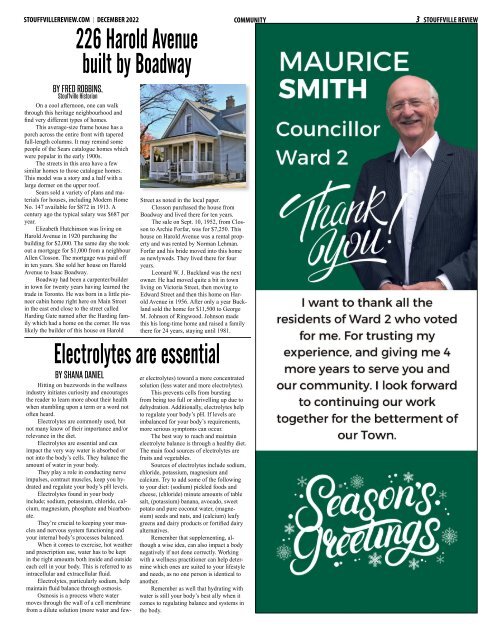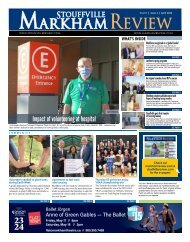Stouffville Review, December 2022
Create successful ePaper yourself
Turn your PDF publications into a flip-book with our unique Google optimized e-Paper software.
STOUFFVILLEREVIEW.COM DECEMBER <strong>2022</strong><br />
226 Harold Avenue<br />
built by Boadway<br />
COMMUNITY<br />
3 STOUFFVILLE REVIEW<br />
BY FRED ROBBINS,<br />
<strong>Stouffville</strong> Historian<br />
On a cool afternoon, one can walk<br />
through this heritage neighbourhood and<br />
find very different types of homes.<br />
This average-size frame house has a<br />
porch across the entire front with tapered<br />
full-length columns. It may remind some<br />
people of the Sears catalogue homes which<br />
were popular in the early 1900s.<br />
The streets in this area have a few<br />
similar homes to those catalogue homes.<br />
This model was a story and a half with a<br />
large dormer on the upper roof.<br />
Sears sold a variety of plans and materials<br />
for houses, including Modern Home<br />
No. 147 available for $872 in 1913. A<br />
century ago the typical salary was $687 per<br />
year.<br />
Elizabeth Hutchinson was living on<br />
Harold Avenue in 1920 purchasing the<br />
building for $2,000. The same day she took<br />
out a mortgage for $1,000 from a neighbour<br />
Allen Closson. The mortgage was paid off<br />
in ten years. She sold her house on Harold<br />
Avenue to Isaac Boadway.<br />
Boadway had been a carpenter/builder<br />
in town for twenty years having learned the<br />
trade in Toronto. He was born in a little pioneer<br />
cabin home right here on Main Street<br />
in the east end close to the street called<br />
Harding Gate named after the Harding family<br />
which had a home on the corner. He was<br />
likely the builder of this house on Harold<br />
Street as noted in the local paper.<br />
Closson purchased the house from<br />
Boadway and lived there for ten years.<br />
The sale on Sept. 10, 1952, from Closson<br />
to Archie Forfar, was for $7,250. This<br />
house on Harold Avenue was a rental property<br />
and was rented by Norman Lehman.<br />
Forfar and his bride moved into this home<br />
as newlyweds. They lived there for four<br />
years.<br />
Leonard W. J. Buckland was the next<br />
owner. He had moved quite a bit in town<br />
living on Victoria Street, then moving to<br />
Edward Street and then this home on Harold<br />
Avenue in 1956. After only a year Buckland<br />
sold the home for $11,500 to George<br />
M. Johnson of Ringwood. Johnson made<br />
this his long-time home and raised a family<br />
there for 24 years, staying until 1981.<br />
Electrolytes are essential<br />
BY SHANA DANIEL<br />
Hitting on buzzwords in the wellness<br />
industry initiates curiosity and encourages<br />
the reader to learn more about their health<br />
when stumbling upon a term or a word not<br />
often heard.<br />
Electrolytes are commonly used, but<br />
not many know of their importance and/or<br />
relevance in the diet.<br />
Electrolytes are essential and can<br />
impact the very way water is absorbed or<br />
not into the body’s cells. They balance the<br />
amount of water in your body.<br />
They play a role in conducting nerve<br />
impulses, contract muscles, keep you hydrated<br />
and regulate your body’s pH levels.<br />
Electrolytes found in your body<br />
include; sodium, potassium, chloride, calcium,<br />
magnesium, phosphate and bicarbonate.<br />
They’re crucial to keeping your muscles<br />
and nervous system functioning and<br />
your internal body’s processes balanced.<br />
When it comes to exercise, hot weather<br />
and prescription use, water has to be kept<br />
in the right amounts both inside and outside<br />
each cell in your body. This is referred to as<br />
intracellular and extracellular fluid.<br />
Electrolytes, particularly sodium, help<br />
maintain fluid balance through osmosis.<br />
Osmosis is a process where water<br />
moves through the wall of a cell membrane<br />
from a dilute solution (more water and fewer<br />
electrolytes) toward a more concentrated<br />
solution (less water and more electrolytes).<br />
This prevents cells from bursting<br />
from being too full or shrivelling up due to<br />
dehydration. Additionally, electrolytes help<br />
to regulate your body’s pH. If levels are<br />
imbalanced for your body’s requirements,<br />
more serious symptoms can occur.<br />
The best way to reach and maintain<br />
electrolyte balance is through a healthy diet.<br />
The main food sources of electrolytes are<br />
fruits and vegetables.<br />
Sources of electrolytes include sodium,<br />
chloride, potassium, magnesium and<br />
calcium. Try to add some of the following<br />
to your diet: (sodium) pickled foods and<br />
cheese, (chloride) minute amounts of table<br />
salt, (potassium) banana, avocado, sweet<br />
potato and pure coconut water, (magnesium)<br />
seeds and nuts, and (calcium) leafy<br />
greens and dairy products or fortified dairy<br />
alternatives.<br />
Remember that supplementing, although<br />
a wise idea, can also impact a body<br />
negatively if not done correctly. Working<br />
with a wellness practitioner can help determine<br />
which ones are suited to your lifestyle<br />
and needs, as no one person is identical to<br />
another.<br />
Remember as well that hydrating with<br />
water is still your body’s best ally when it<br />
comes to regulating balance and systems in<br />
the body.


















